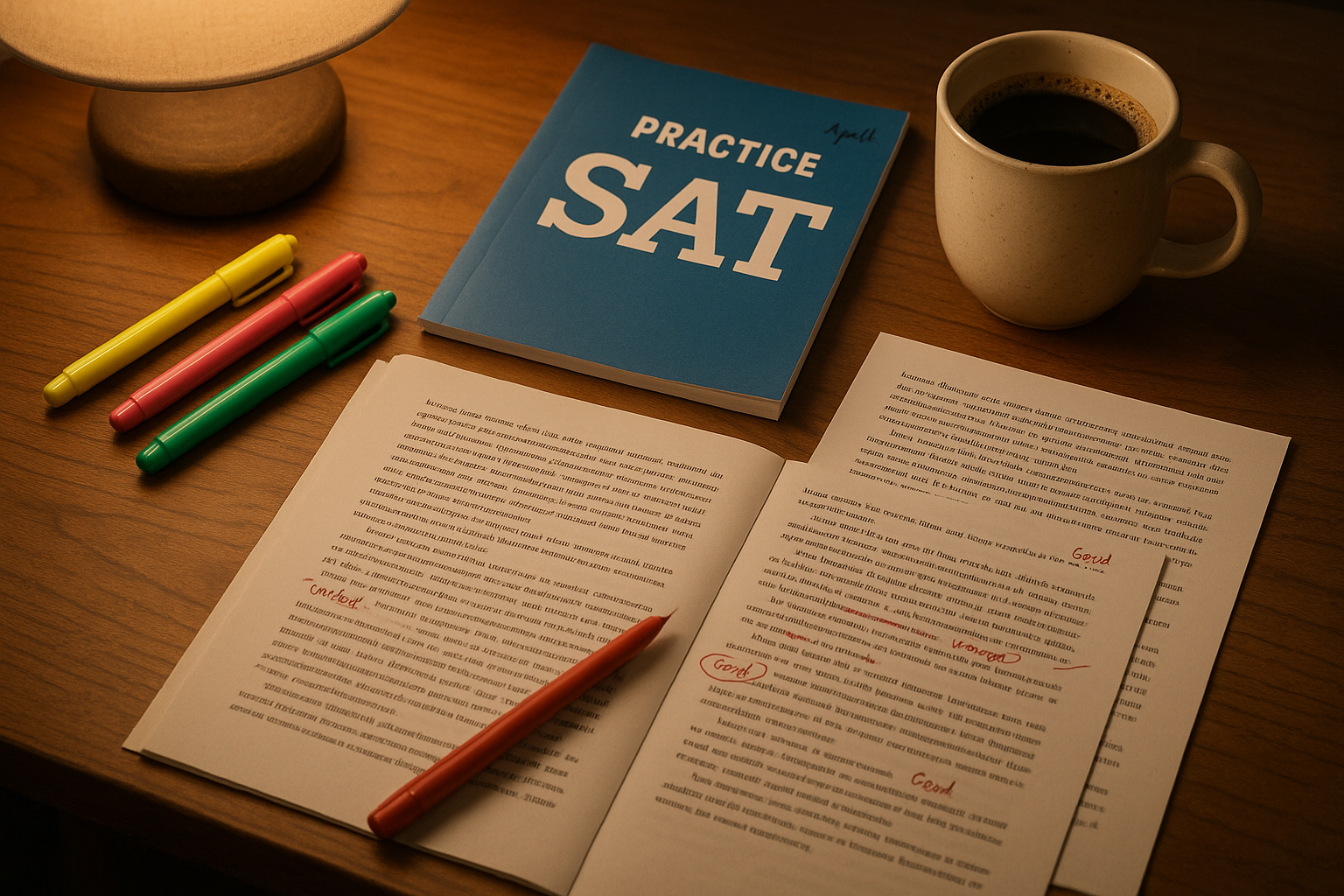How to Balance SAT Prep With College Essay Writing: A Practical, Stress-Free Plan
Senior year feels like an Olympic decathlon for your brain: timed exams, extracurriculars, applications, and that one essay that feels like it will define you. The good news? You don’t have to sprint everything at once. Balancing SAT prep with college essay writing is not only possible — it can be strategic, even energizing. With a clear plan, a few productivity tricks, and the right support (think 1-on-1 guidance and tailored study plans like Sparkl’s personalized tutoring offers), you’ll be able to produce a competitive SAT score and a compelling personal essay without burning out.
Why this balance matters
Both the SAT and your college essays aim to present different sides of the same candidate. The SAT measures academic readiness with timed, convergent tasks; your essay shows the divergent, reflective, human side — voice, values, and narrative. Neglecting one can make your application lopsided. But overdoing both at once can hurt performance: cramming for an SAT section increases stress and reduces the creativity you need for meaningful writing. The goal is synergy — practice that sharpens your test-taking habits while protecting windows for reflection and revision.
A quick reality check: What the SAT really is today
Before plotting your calendar, keep a few facts in mind:
- The SAT is scored from 400 to 1600, with two section scores (Evidence-Based Reading and Writing, and Math) each reported between 200 and 800.
- The standard SAT (without the essay) lasts about three hours. The College Board phased out the optional essay in most administrations; check your target colleges if you think you might need it.
- Practice tests are gold. Full-length, timed practice tests help you build stamina and identify patterns in mistakes.
Step 1: Decide your priorities and deadlines
Start by answering two simple questions: When is your SAT test date? When are your college application deadlines and early decision/early action windows? Map these dates visually — on a calendar or a digital planner.
Make a priority matrix
Not all tasks are equal. Here’s a quick matrix to help you decide where to focus when. Place each task in one of the four boxes:
- Urgent and important: e.g., SAT a week away, application due tomorrow
- Important but not urgent: e.g., a college essay draft due in three weeks
- Urgent but less important: e.g., a short assignment that takes 30 minutes
- Neither urgent nor important: social media scrolls, TV binges
This helps you avoid the trap of spending essay energy on low-impact tasks when your SAT is imminent, and vice versa.
Step 2: Build a weekly rhythm — the 80/20 approach
You don’t need to split your time 50/50. Think in terms of focus blocks and diminishing returns. For most students, allocating around 60–80% of focused study time to the task with the nearer deadline works well. Here’s a flexible template:
- If your SAT is within a month: 60% SAT work, 30% essays, 10% rest/other.
- If your SAT is months away but essays are due soon: 30% SAT practice, 60% essays, 10% rest/other.
- If both are months away: aim for a balanced 50/50, rotating focus days (e.g., Mon/Wed/Fri SAT; Tue/Thu/Sat essay).
The idea is to concentrate high-quality energy where it will move the needle most.
Sample weekly plan (two-week snapshot)
| Day | SAT Focus | Essay Focus | Other |
|---|---|---|---|
| Monday | 1.5 hours: Math practice (no-calculator) | 45 min: Brainstorm possible essay anecdotes | Evening: 30 min relaxation |
| Tuesday | 1 hour: Timed Reading passage | 1 hour: Outline first essay draft | Late afternoon walk |
| Wednesday | 2 hours: Full practice section + review | 30 min: Freewriting (story details) | 30 min: Light review of schoolwork |
| Thursday | 1 hour: Grammar drills (Writing & Language) | 1.5 hours: Drafting | Evening hobby time |
| Friday | 1.5 hours: Mixed practice | 45 min: Peer review / Feedback | Social time |
| Saturday | 3 hours: Full-length practice test (every other week) | 2 hours: Revise essay (on alternate weekends) | Rest afternoon |
| Sunday | Review practice test mistakes | Work on supplemental essays or personal statement polishing | Plan the coming week |
This is just a template. The true test is consistency. A 45-minute focused session every day beats three marathon nights in a row.
Step 3: Use cognitive science to structure your work
Your brain distinguishes between two broad cognitive modes: focused, convergent thinking (perfect for SAT problems) and diffuse, associative thinking (perfect for drafting essays). Switching between them without a gap can be costly. Try these transitions:
- After a hard SAT session, take a 20–30 minute break before attempting creative writing.
- Use active rest: take a walk, do light chores, or sketch to allow ideas to incubate.
- Save your freshest morning hours for the task that needs deep focus — for many students, that’s SAT practice. For others, first thing might be best for personal writing.
Pomodoro and task batching
Pomodoro (25-min focus, 5-min break) is great for problem sets and short grammar drills. For essays, extend to 45–60 minute focused blocks so you can get into flow. Batch similar tasks: do all grammar drills in one session; block time for brainstorming multiple essay prompts at once. Batching reduces context switching cost.
Step 4: Build strategic overlaps — practice that pulls double duty
You can design practice so it benefits both goals. Here are ways to combine effort efficiently:
- Reading for the SAT improves diction and rhetorical awareness. Use challenging passages to collect vivid language and sentence structures you admire and adapt (not copy) in your essays.
- Timed reading practice increases focus and stamina — helpful for college applications’ timed interviews or deadlines.
- Editing essays for concision is a grammatical exercise too. Keep a short list of common syntax or comma errors you encounter on both essays and SAT Writing & Language questions.
Example: Turn a practice passage into essay material
Approach a dense SAT passage like a researcher: annotate strong metaphors, note the tone shift, and pull three descriptive phrases you could adapt to start an anecdote. This sharpens your analytical eye and builds a personal library of language to draw on when you draft.
Step 5: Use practice tests and drafts as feedback loops
High-quality feedback is the fastest route to improvement. For the SAT, frequent timed practice tests reveal pacing and error patterns. For essays, draft–revise cycles with targeted feedback improve voice and clarity.
A practical cadence for feedback
- Every 2–3 weeks: take a full SAT practice test under timed conditions and spend equal time reviewing errors.
- Every 1–2 weeks: finish an essay draft and get one round of feedback from a trusted reviewer — a teacher, counselor, or a tutor.
- Use a checklist for reviews: clarity of idea, narrative arc, specificity of details, grammar, and tone.
Sparkl’s personalized tutoring can help here by offering expert tutors who give targeted feedback and AI-driven insights to track your progress over time — making each practice test and essay draft a stepping stone rather than a stress point.
Step 6: Specific strategies for the SAT sections while writing essays

Reading
Strategy: focus on main idea, author’s purpose, and passage structure. When reading for practice, annotate—underline topic sentences, summarize paragraphs in the margin, and write a one-sentence thesis for the passage. This habit sharpens comprehension and reduces wasted time on test day.
Writing & Language
Strategy: master grammar patterns (agreement, verb tense, commas, parallelism) and rhetorical skills (conciseness, tone, transitions). Editing your college essays for clarity and concise phrasing doubles as test prep. Keep a personal error log and try to avoid repeating the same mistakes in both contexts.
Math
Strategy: build a routine: drill fundamentals, practice timed sections, then review mistakes slowly. Math builds confidence. Allocating short daily math blocks can make the rest of your week smoother and free up time for essay revision.
Step 7: Writing the essay — a staged approach
College essays respond to prompts that ask for reflection, growth, or explanation of context. A staged approach keeps this manageable alongside SAT prep.
Stage 1 — Discovery (1–3 sessions)
- Freewrite memorable moments for 15–20 minutes: setbacks, triumphs, small reveals.
- List emotions, lessons learned, and specific sensory details tied to each moment.
- Choose the moment that best shows growth or perspective shift, not just achievement.
Stage 2 — Drafting (2–4 sessions)
- Start with a hook — a scene, not a statement. Let specificity do the heavy lifting.
- Build a narrative arc: situation → conflict/tension → reflection/insight.
- Aim for a single, clear idea per paragraph. Keep sentences varied and concise.
Stage 3 — Revision and polishing (3–5 sessions)
- Cut redundancies. Read aloud to catch cadence and awkward phrasing.
- Get feedback: at least one structural read and one detailed proofreading pass.
- Make final adjustments for tone and specificity. Make sure each sentence earns its space.
Step 8: Maintain wellbeing — sleep, food, and perspective
High achievers often sacrifice sleep before big tests or deadlines. Don’t. Sleep consolidates memory and helps creative insight. If your weekend is blocked with a practice test, plan a restful Sunday evening where you recharge. Simple routines — consistent sleep, hydration, short exercise, and time with friends — provide more productivity than an extra all-nighter.
Stress-management tools that really work
- Micro-exercises: 5–10 minutes of stretching or a brisk walk between sessions.
- Meditation or breathing exercises for 5 minutes before a practice test to steady nerves.
- Set non-negotiable breaks: no work after 10:30 PM, dinners with family or friends to reset perspective.
Step 9: When to ask for help
Knowing when to get outside support is crucial. If you’re stuck on a persistent SAT section score plateau, or your essay drafts aren’t improving after multiple revisions, it’s time to bring in an expert. Tutors can offer targeted strategies, customized practice plans, and faster, smarter feedback loops.
Sparkl’s personalized tutoring pairs students with expert tutors for 1-on-1 guidance and leverages AI-driven insights to focus practice on weak spots. Whether you need pacing help on SAT Reading or coaching to strengthen your essay voice, a tailored plan can make your preparation more efficient and less stressful.
Step 10: Final two-week sprint — what to do
When you’re two weeks out from an SAT test or essay deadline, tighten the routine:
- Reduce the volume of new material. Prioritize review and consolidation.
- For the SAT: take one full practice test the week before, do focused drills on weaknesses, and taper the day before the test.
- For essays: finalize your best draft, do a final proofread, and submit early if possible to avoid technical glitches.
Sample 2-week checklists
| SAT (2 weeks out) | Essay (2 weeks out) |
|---|---|
|
|
Real students, real strategies — short case studies
Case study 1: Maya, busy varsity athlete
Maya had an SAT two months away and several supplemental essays due in three weeks. She used a Pomodoro schedule for SAT drills in the morning, saved evenings for freewriting, and scheduled weekend full tests every other week. She worked with a tutor for one-hour weekly check-ins to refine pacing and brainstorming. Result: she improved her Reading score by 80 points and completed essays early without sacrificing practice tests.
Case study 2: Alex, perfectionist writer
Alex loved writing but was anxious about test timing. He devoted mornings to timed SAT practice to build speed and used afternoons for essay drafts, focusing on concise storytelling. He tracked recurring sentence-level issues from SAT Writing and applied those edits to his essays. The cross-training helped: his grammar errors went down on practice tests, and his final essay became clearer and punchier.
Final thoughts: Make a plan you can actually keep
Balancing SAT prep with college essay writing isn’t about heroic all-nighters. It’s about planning, smart scheduling, and feedback. Treat both as iterative processes: practice tests and essay drafts are data points, not destiny. Use them to learn where to focus next.
If you want help tailoring this plan to your personality, schedule, and goals, consider tutoring that meets you where you are. Sparkl’s personalized tutoring pairs expert tutors with AI-driven insights to create tailored study plans, 1-on-1 guidance, and progress tracking that turns stress into steady progress.
Photo idea: A cozy study desk with a practice SAT booklet, annotated essay drafts, highlighters, and a cup of coffee — conveys focused, balanced prep.
Photo idea: A student walking outside during a break with headphones — highlights the importance of active rest and mental reset.
Remember: college admissions look for growth, resilience, and authenticity. A strong SAT score and a sincere, well-crafted essay are complementary pieces of that picture. With a plan that respects both the demands of timed testing and the slow work of personal storytelling, you’ll show admissions committees not only what you know, but who you are.
Go steady, revise often, and don’t forget to breathe — you’ve got this.


















No Comments
Leave a comment Cancel